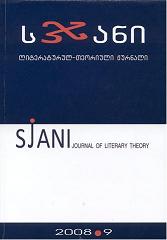გალაკტიონის მონორიმი („იერი“, „ფერად–ფერადი“)
Galaktion's Monorhyme
Author(s): Tamar BarbakadzeSubject(s): Literary Texts
Published by: ლიტერატურის ინსტიტუტის გამომცემლობა
Summary/Abstract: The article deals with the fact that even in the brand new editions of Galaktion Tabidze’s works we come across the same dating of verses without taking into consideration their style, poetics and versification. The research reveals: the peculiarity of Galaktion’s second poetic reform: Approach to the voice of folk poetry, dialect was reflected in verses with common rhyme written in 1928-1958. It is so called mono rhyme, which traditionally belongs to folk poetry. Tabidze’s well-known mono rhyme “Expression” (“Ieri”) is dated by 1915 which in not correct. This poem is directly linked or precedes poet’s mono rhyme: “Colourful-Colourful” (“Peradi-Peradi”), which was written, without doubt, in 1938. Galaktion’s second poetic reform (20-30s of XX century) was about poet’s metrics and rhyme. Galaktioni had paid no attention to thirteen-syllable words and mono-rhyme until 30s. This criterion (44/5) and mono-rhyme is innovation in Galaktion’s versification. It should be noted, that the composition of “Perad-Peradi” (“Colourful-Colourful”), is based not only on mono-rhyme but on the word “voice” as well: “I like hearing this voice”, “I fell in love with this sweat voice”. Dialect should be meant in the voice of folk verses and songs and it found its expression in Galaktion’s 1934-1941 mono-rhymes. Galaktioni managed to write 18 mono-rhymes during these 7 years, third of them (6) are dated by 1938. The word “Tsaieradi”, which is repeated 5 times in 24-line verse, represents the poem’s “Expression” (“Ieri”) key rhyme element. The composition of “Perad-Peradi”(“Colourful-Colourful”) uses double rooted, polylogic composites as a base: vperavdi-perad-peradi-versati-perad-peradi-bedistseramdiamieramdi- perad-peradi. “perad-peradi” is repeated for four times. Thirteen-syllable starts from the epoch of Renaissance, its variations (35/5, 4/4/5, 43/24, 24/43) are most frequently met in Guramishvili’s works. By means of frequency of use 4/4/5 is in the last place. The basis for versification interrelation of analysed mono-rhymes are found. Likeness of “Ieri” and “perad-peradi”, is shown not only with the help of identity of mono-rhymes’ lexical units but with same meter: both mono-rhymes are written by rare criterion – thirteen- syllable – 44/5, which Galaktioni has not used until 30s. The author focuses on the word form that forms compositional basis for Galaktion’s mono-rhyme “Ieri”: rare, exotic, dialectic form: “Tsaieradi”, denoting sudden, poring rain of May. Galaktioni has once mentioned this word in the collection “Artistic Flowers”, then repeats it for four times in “Ieri”. The sound of the rain is connected with folk, childhood sounds, recollecting of which defines Galaktion’s song mood.
Journal: სჯანი
- Issue Year: 2008
- Issue No: 09
- Page Range: 109-116
- Page Count: 8
- Language: Georgian

